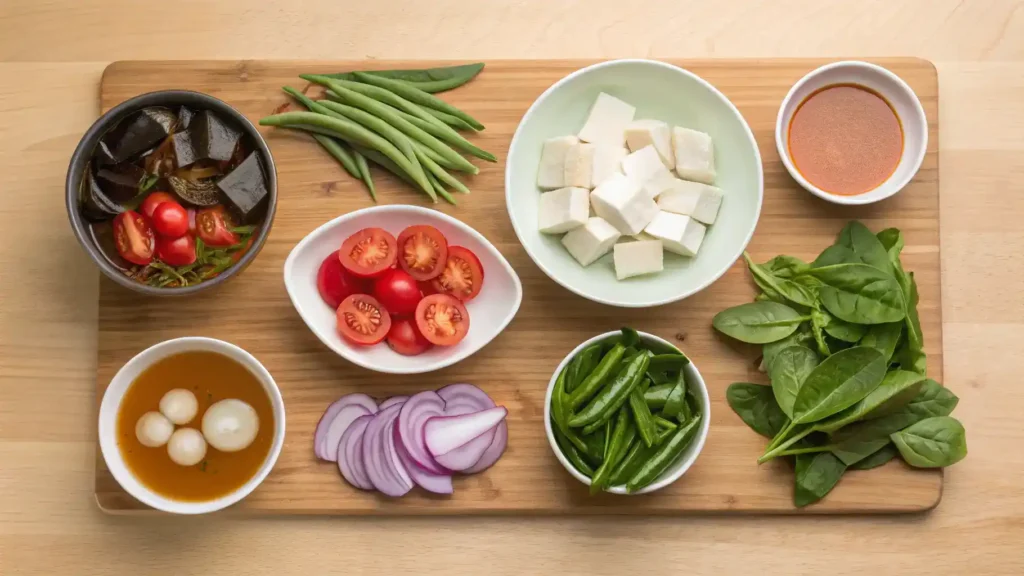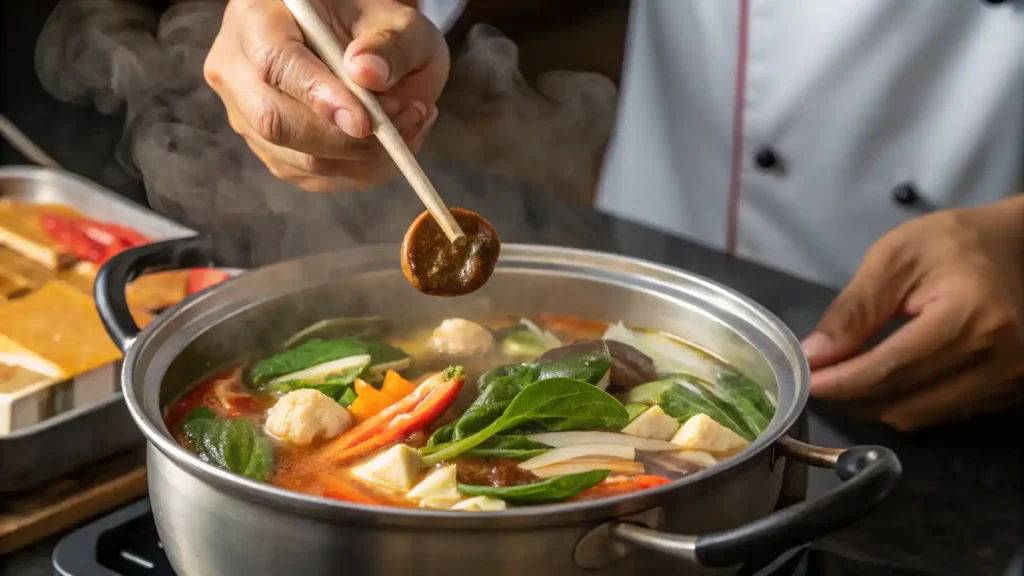Sinigang recipe is a heartwarming dish that brings the flavors of the Philippines right to your kitchen! Imagine a steaming bowl of tangy broth, infused with fresh tamarind, vibrant tomatoes, and a medley of crisp vegetables like radish and eggplant. Instead of pork, we’ll use tender chicken or hearty tofu, simmered to perfection, soaking up all those delightful flavors. Each spoonful is a cozy hug, perfect for sharing with loved ones. Get ready to savor this delightful, zesty comfort food that will warm your soul and brighten your day!
Table of Contents
Why You’ll Love This Recipe
- It’s a warm hug in a bowl, perfect for cozy nights.
- Customizable with your favorite veggies and proteins.
- Simple ingredients make it easy to whip up any day.
- Rich, tangy flavor that dances on your taste buds.
- Healthy and nourishing, great for the whole family.

sinigang recipe
Ingredients
Equipment
Method
- Collect fresh vegetables like radish, eggplant, and green beans. Grab some tomatoes and onions too. For protein, use chicken or shrimp. Don’t forget the tamarind paste for that signature tang!
- In a large pot, add water and bring it to a gentle boil. Toss in the chopped onions and tomatoes. Let them simmer until soft and fragrant.
- Introduce your chicken or shrimp to the pot. Cook until they are tender and fully cooked through. This will add a lovely depth to your broth.
- Now, add the radish, eggplant, and green beans. Stir gently and let them cook until they are just tender, keeping that vibrant color!
- Mix in the tamarind paste, adjusting to your taste. This is where the magic happens, giving your sinigang that delightful sourness!
- Sprinkle in salt and pepper to taste. Feel free to add a bit of fish sauce for an extra umami kick!
- Once everything is cooked and flavors melded, ladle your sinigang into bowls. Serve hot with steamed rice and a smile!
Recipe Snapshot
| Feature | Details |
|---|---|
| Category: | Main Dish |
| Cuisine: | Filipino |
| Prep Time: | 15 minutes |
| Cook Time: | 45 minutes |
| Total Time: | 1 hour |
| Dietary: | Gluten-Free, Dairy-Free |
| Serves: | 4-6 people |
| Best Served: | Hot with rice |
Ingredients

- Water – Essential for creating the broth base.
- Tomatoes – Adds a tangy flavor and freshness to the dish.
- Onion – Enhances the overall flavor with its sweetness.
- Radish – Provides a crunchy texture and mild peppery taste.
- Eggplant – Adds a creamy texture when cooked.
- Green beans – Offers a nice crunch and vibrant color.
- Tofu – A great protein substitute for a hearty meal.
- Fish sauce – Adds umami depth; use sparingly for flavor.
- Lime or calamansi juice – Brings a zesty brightness to the soup.
- Spinach or water spinach – Adds a nutritious green element.
Ingredients with measurements will be right under the article in the recipe card.
How to Make the Recipe

Get ready to create a warm bowl of sinigang that will hug your taste buds!
Step 1: Gather Your Ingredients
Collect fresh vegetables like radish, eggplant, and green beans. Grab some tomatoes and onions too. For protein, use chicken or shrimp. Don’t forget the tamarind paste for that signature tang!
Step 2: Prepare the Broth
In a large pot, add water and bring it to a gentle boil. Toss in the chopped onions and tomatoes. Let them simmer until soft and fragrant.
Step 3: Add Your Protein
Introduce your chicken or shrimp to the pot. Cook until they are tender and fully cooked through. This will add a lovely depth to your broth.
Step 4: Incorporate the Vegetables
Now, add the radish, eggplant, and green beans. Stir gently and let them cook until they are just tender, keeping that vibrant color!
Step 5: Add the Tamarind Paste
Mix in the tamarind paste, adjusting to your taste. This is where the magic happens, giving your sinigang that delightful sourness!
Step 6: Season to Perfection
Sprinkle in salt and pepper to taste. Feel free to add a bit of fish sauce for an extra umami kick!
Step 7: Serve and Enjoy
Once everything is cooked and flavors melded, ladle your sinigang into bowls. Serve hot with steamed rice and a smile!
Pro Tips for Making the Recipe

- Use fresh tamarind or a tamarind paste for a more authentic sour flavor.
- Experiment with different proteins like shrimp or chicken for variety.
- Add vegetables like radish and eggplant for extra texture and nutrition.
- Let the broth simmer longer for deeper flavors; patience pays off!
- Serve with steamed rice to soak up the delicious broth.
How to Serve

Enjoy your sinigang with these delightful serving suggestions:
- Serve hot with a side of steamed jasmine rice for a comforting meal.
- Add a squeeze of fresh lime or calamansi for an extra zing.
- Top with fresh herbs like cilantro or green onions for a burst of flavor.
- Pair with crispy fried tofu or grilled chicken for added protein.
- Offer a side of lumpia (spring rolls) for a crunchy contrast.
- Enjoy with a refreshing cucumber salad to balance the savory broth.
- For a twist, serve with quinoa or brown rice for a healthier option.
- Garnish with sliced chili peppers for those who love a spicy kick.
Make Ahead and Storage

Proper storage of your sinigang ensures that you can enjoy its delightful flavors later. Here’s how to handle leftovers, freeze, and reheat your dish.
Storing Leftovers
• Allow the sinigang to cool to room temperature before storing.
• Transfer leftovers to an airtight container.
• Store in the refrigerator for up to 3 days.
• Label the container with the date for easy tracking.
Freezing
• Portion the sinigang into freezer-safe containers.
• Leave some space at the top for expansion.
• Seal tightly and label with the date.
• Freeze for up to 3 months for best quality.
Reheating
• Thaw frozen sinigang in the refrigerator overnight.
• Reheat on the stovetop over medium heat, stirring occasionally.
• Add a splash of water or broth if it’s too thick.
• Heat until warmed through, ensuring not to boil.
FAQs
What can I use as a substitute for pork in sinigang?
You can use chicken, beef, or even tofu for a vegetarian option. These alternatives will still provide a delicious flavor and texture to your sinigang.
How can I make sinigang less sour?
If you prefer a milder taste, reduce the amount of tamarind or use a sweeter variety of tomatoes. You can also add a bit of sugar to balance the sourness.
Can I add other vegetables to my sinigang?
Absolutely! Feel free to include vegetables like carrots, bell peppers, or even eggplant. They will enhance the dish’s flavor and nutritional value.
How long does sinigang last in the fridge?
Sinigang can last up to 3-4 days in the fridge. Just make sure to store it in an airtight container to keep it fresh and flavorful.
Final Thoughts
There you have it—your very own sinigang recipe, ready to warm your heart and soul! This delightful dish is not just a meal; it’s a hug in a bowl. So gather your loved ones, savor the tangy goodness, and enjoy the simple pleasure of cooking together. Remember, every spoonful is a step towards comfort and joy. Happy cooking, and may your kitchen be filled with laughter!
Hungry for more delicious creations? Browse our site for more recipes and endless inspiration to spark your next culinary adventure!

